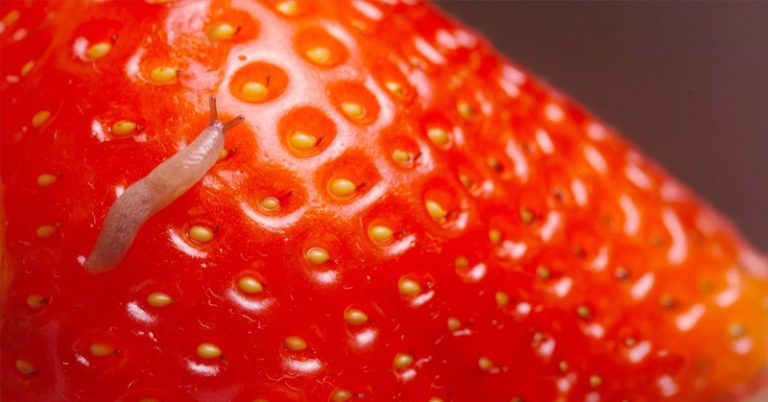One of the best parts about the summer season is the array of local fresh fruit available on grocery store shelves, at farmers’ markets, and road-side stands. A recent viral TikTok video may have you second-guessing picking up that pint of fresh strawberries you were eyeing. Ever hear of strawberry worms?
The video in question features someone plunging fresh strawberries into a bowl of salt water and watching as several small, white worm-like creatures crawl out and float to the surface. These strawberry worms are now creating a sensation on the internet, and everyone is asking the same question: is fresh fruit safe to eat? A slew of people looking to see the bugs for themselves have created their own videos, one of which we feature in this article.
Strawberry Worms- What Are They?
The tiny worms in the video are actually the maggots of an invasive species of fly known as the spotted wing drosophila (SWD). They come from East Asia and have been present in the United States since 2008 [1].
The difference between these flies and other species that infest fruit is that they have a serrated egg-laying device called an ovipositor, which allows them to lay eggs inside ripe, undamaged fruit. Most other species lay their eggs only in rotting or damaged berries.
Small fruit crop entomologist, Sriyanka Lahiri, Ph.D., an assistant professor at the University of Florida, explains that the female fly lays her eggs inside the ripe fruit, and when the maggots hatch they continue to feed off of the inside of the berry.
“The maggots go largely undetected during harvest. Since common fruit flies can only lay their eggs in softening, damaged, or rotting fruit, the maggots hitchhiking inside fresh-looking fruit definitely belong to the SWD species,” she says [1].
Lahiri says that the SWD is particularly attracted to strawberries because of the yeast and sugar water solution that is commonly used as a monitoring device during berry production.
How Can They be Managed?
Lahiri says that they are not the only pests that can cause damage to fresh fruit. Thrips, mites, aphids, and armyworms can be problematic as well, but if they are all intensively managed, no infestation should become a major issue.
Once the SWD eggs have been laid, however, there is nothing that can be done. As such, pest management focuses on preventing the flies from laying eggs on the fruit in the first place.
“Timely picking of ripe fruits, removal of rotting fruits, and burial of damaged fruits are good cultural practices to control SWD, because these flies are attracted to a fermenting fruity smell,” says Lahiri [1].
What Happens if I eat a Strawberry Worm?
The real question that everyone is asking is “what happens if I eat one of these worms by accident?”
For most people living in cooler climates, such as in the United States, accidentally eating a few maggots is unlikely to cause any harm. In fact, you have most likely already eaten a maggot now and again throughout your life and didn’t even notice [2].
Eating maggots themselves are actually quite safe, however, the problem is that you might be susceptible to whatever that larvae were exposed to. If they were exposed to rotting fruit, for example, there is a higher likelihood that they could be carrying bacteria or some other kind of pathogen. This is what can lead to food poisoning [3].
In some countries, it is actually common to eat maggots as a food source. Maggots are particularly high in protein and fat, and so can be a good source of cheap nutrition that actually has a very low carbon footprint. In these cases, however, the worms are cooked, which reduces the potential that they could be carrying microbes, parasites, or bacteria.
Currently, scientists are looking into ways that these worms can be used to actually create a type of textured protein that could be more sustainable than consuming animal meat as a protein source in our diets. At this time though, the risks involved with eating these organisms still outweigh the potential benefits [3].
How to Avoid Eating Maggots
Lahiri strongly recommends thoroughly washing all of your fresh fruits and vegetables before eating them. Since the SWD eggs have been laid deep inside the undamaged fruit, she suggests submerging them in water for a prolonged period of time (the TikTok video did so for thirty minutes) to force the worms out.
Lahiri has not conducted any research to show how adding salt to the water is beneficial, and she is unsure as to whether or not this makes the practice more effective.
“Also,” she adds, “I am not sure the fresh strawberry taste will remain the same after being submerged in saltwater for too long,” [1]
She wants to assure people that eating a few maggots now and again will not have any dramatic impact on their health, and if you do eat a couple, all you did was get a little extra protein with your snack. She also notes that the FDA has guidelines as to how many bugs are allowed to be inside foods since the number of pesticides that would be required to have a zero-bug tolerance would be astronomical. This, she added, would have a worse impact on human health than the bugs.
“Having pesticide residue on our food versus having to ingest some extra animal protein can be considered as a fair trade-off.” [1]
The moral of the story? Wash your produce thoroughly, and enjoy what the season has to offer.
Sources
- ‘Why Are Worms Coming Out of Strawberries in This Viral Video? We Asked an Expert to Explain’ Health Claire Gillespie. Published May 21, 2020
- ‘The health effects of eating maggots’ Medical News Daily Charlotte Lillis. Published May 29, 2019
- ‘I Accidentally Ate Maggots. Now What?’ Healthline Emily Cronkleton. Updated March 1, 2019

